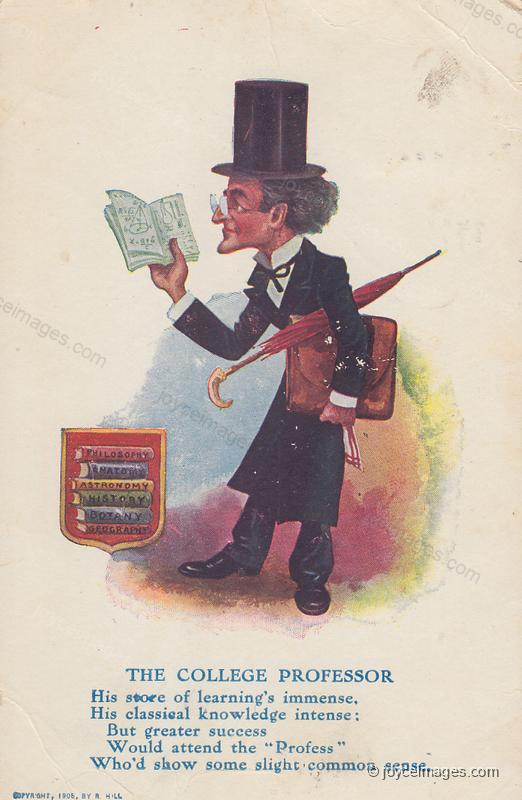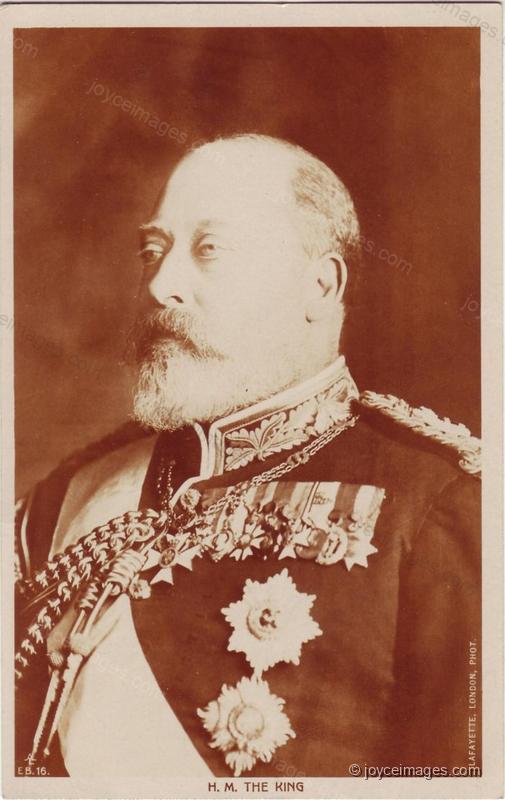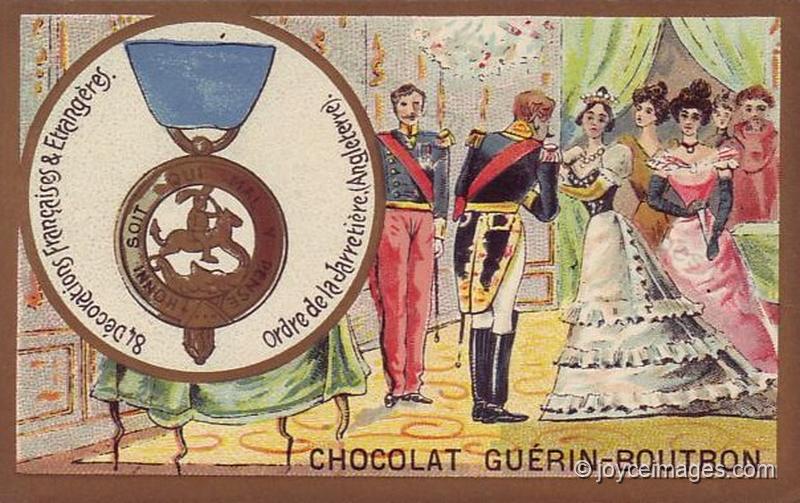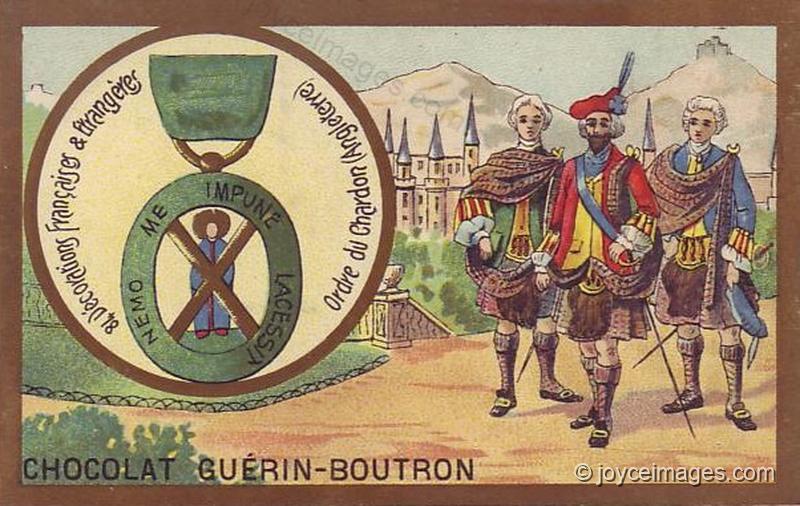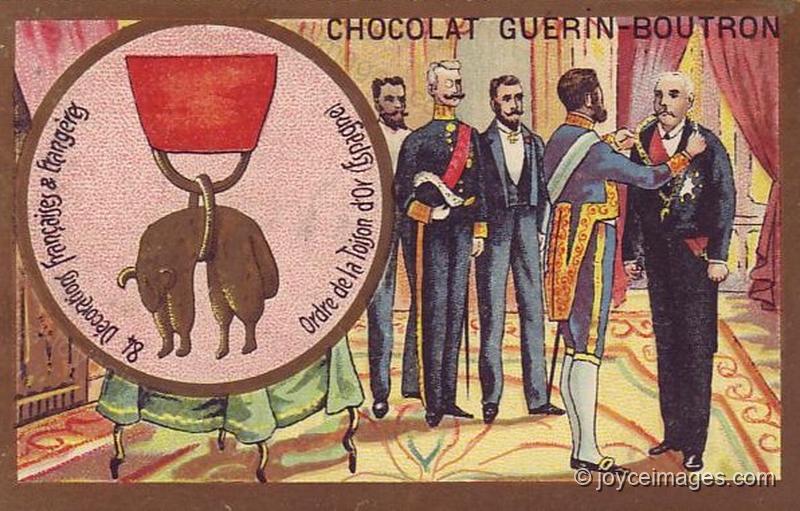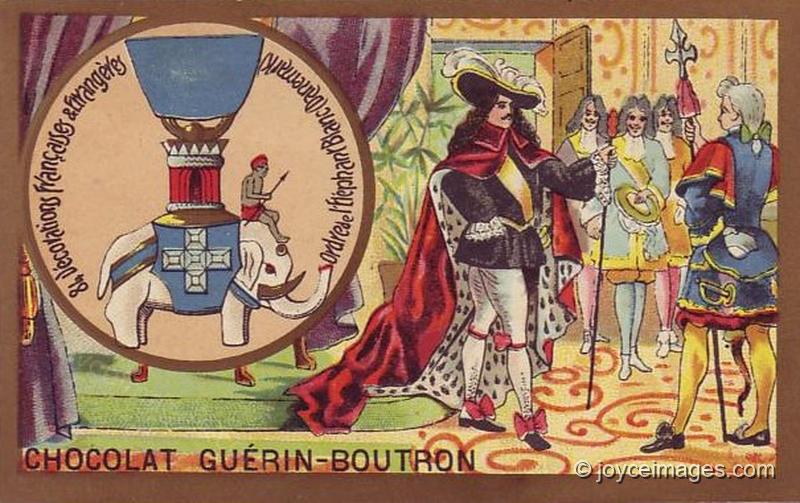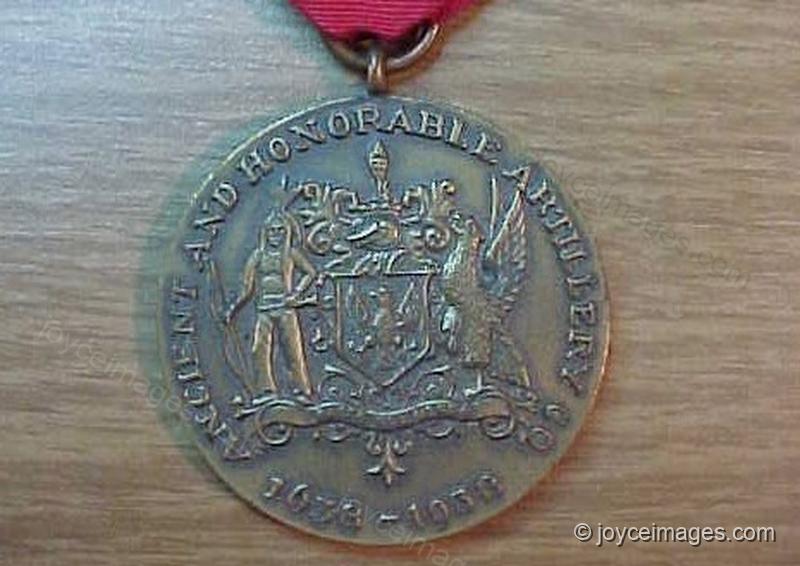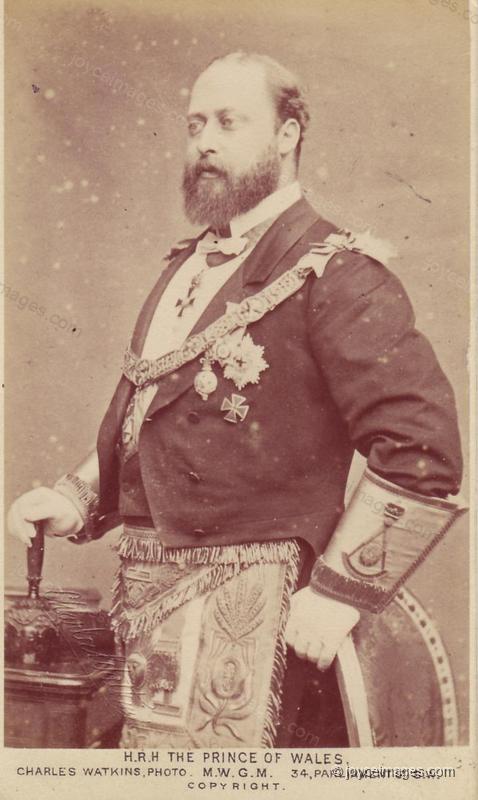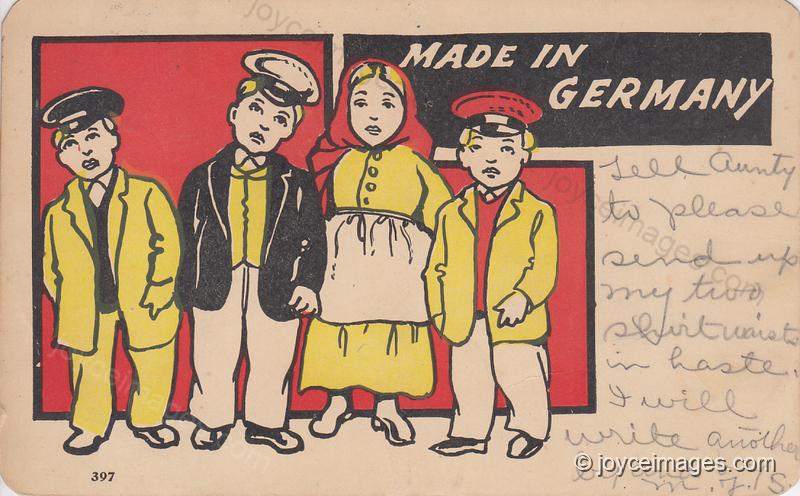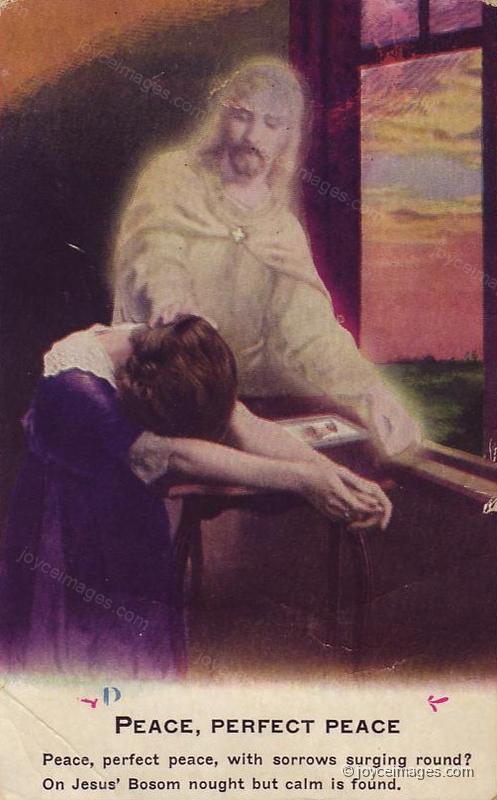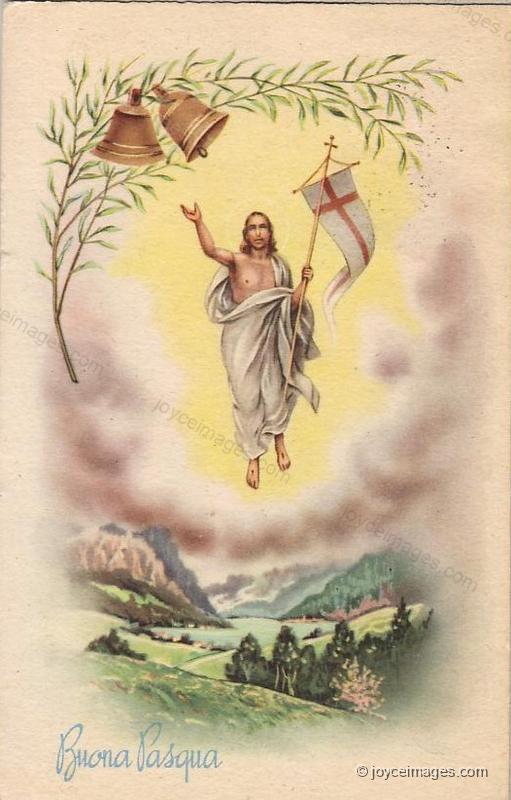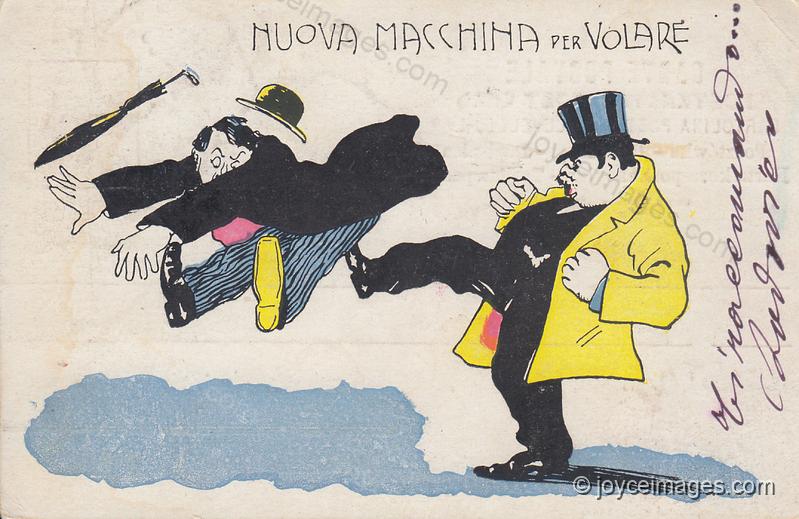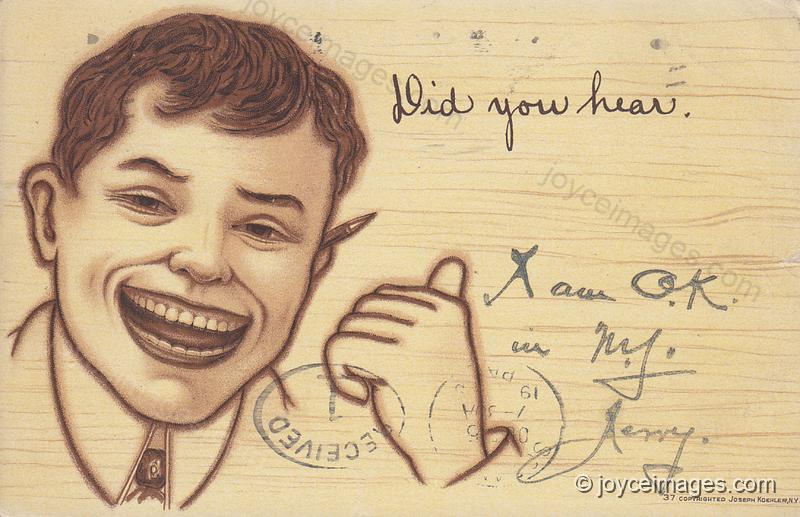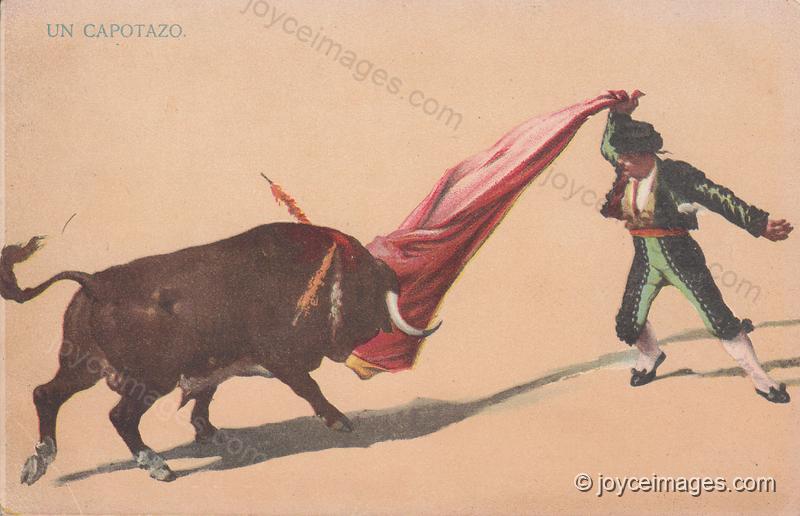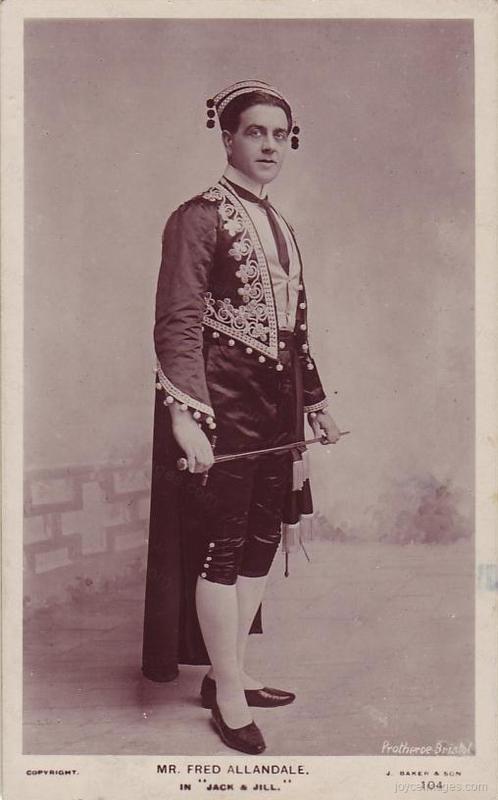"BIDDY THE CLAP
Did you hear what the professor said? He's a professor out of the college.
CUNTY KATE
I did. I heard that.
BIDDY THE CLAP
He expresses himself with such marked refinement of phraseology.
CUNTY KATE
Indeed, yes. And at the same time with such apposite trenchancy."
(U15.4438)
Did you hear what the professor said? He's a professor out of the college.
CUNTY KATE
I did. I heard that.
BIDDY THE CLAP
He expresses himself with such marked refinement of phraseology.
CUNTY KATE
Indeed, yes. And at the same time with such apposite trenchancy."
(U15.4438)
"PRIVATE CARR
(pulls himself free and comes forward) What's that you're saying about my king?
(Edward the Seventh appears in an archway. He wears a white jersey on which an image of the Sacred Heart is stitched"
(U15.4446)
(pulls himself free and comes forward) What's that you're saying about my king?
(Edward the Seventh appears in an archway. He wears a white jersey on which an image of the Sacred Heart is stitched"
(U15.4446)
"with the insignia of Garter" (U15.4451)
The Order of the Garter is an order of chivalry founded by King Edward III ca. 1350. Membership is limited to the sovereign, the Prince of Wales, 24 members, plus selected "extra" knights and ladies (British Royal Family, or foreign monarchs). Its emblem is a garter with the motto 'Honi soit qui mal y pense' (Old French: Shame upon him who thinks evil upon it), The badge shows St George slaying a dragon, encircled by the garter. It is ceremonially worm around the left calf by knights, and the left arm by ladiesEdward was indeed a Knight of the Garter (1858).
The Order of the Garter is an order of chivalry founded by King Edward III ca. 1350. Membership is limited to the sovereign, the Prince of Wales, 24 members, plus selected "extra" knights and ladies (British Royal Family, or foreign monarchs). Its emblem is a garter with the motto 'Honi soit qui mal y pense' (Old French: Shame upon him who thinks evil upon it), The badge shows St George slaying a dragon, encircled by the garter. It is ceremonially worm around the left calf by knights, and the left arm by ladiesEdward was indeed a Knight of the Garter (1858).
"and Thistle," (U15.4451)
The Order of the Thistle is an order of chivalry associated with Scotland. An ancient Order, it was revived by James VII (also King of England as James II) in 1687. The Order consists of the Sovereign (who alone grants membership) and 16 (Scottish-borne) Knights and Ladies, plus "extra" knights (members of the British Royal Family, or foreign monarchs). The Order's emblem is the thistle. Its badge depicts St Andrew, wearing a green gown and purple coat, holding a saltire, surrounded by the Order's motto 'Nemo me impune lacessit' (Latin: No one provokes me with impunity). Edward was indeed a Knight of the Thistle (1867).
The Order of the Thistle is an order of chivalry associated with Scotland. An ancient Order, it was revived by James VII (also King of England as James II) in 1687. The Order consists of the Sovereign (who alone grants membership) and 16 (Scottish-borne) Knights and Ladies, plus "extra" knights (members of the British Royal Family, or foreign monarchs). The Order's emblem is the thistle. Its badge depicts St Andrew, wearing a green gown and purple coat, holding a saltire, surrounded by the Order's motto 'Nemo me impune lacessit' (Latin: No one provokes me with impunity). Edward was indeed a Knight of the Thistle (1867).
"Golden Fleece," (U15.4451)
The Spanish Order of the Golden Fleece (Spanish: Orden del Toisón de Oro) is an order of chivalry founded in 1430 by Duke Philip III of Burgundy. It was initially restricted to a 24 knights, increased to 30 in 1433 and 50 in 1516—plus the sovereign. The Order was initially denied to "heretics"; Wellington became (1812) the first non-Catholic member. The insigna is a sheepskin, suspended from a jewelled collar of firesteels in the shape of the letter B, for Burgundy. Edward was indeed a Knight of the Golden Fleece (1852).
The Spanish Order of the Golden Fleece (Spanish: Orden del Toisón de Oro) is an order of chivalry founded in 1430 by Duke Philip III of Burgundy. It was initially restricted to a 24 knights, increased to 30 in 1433 and 50 in 1516—plus the sovereign. The Order was initially denied to "heretics"; Wellington became (1812) the first non-Catholic member. The insigna is a sheepskin, suspended from a jewelled collar of firesteels in the shape of the letter B, for Burgundy. Edward was indeed a Knight of the Golden Fleece (1852).
"Elephant of Denmark, Skinner's and Probyn's horse, Lincoln's Inn bencher" (U15.4451)
The Order of the Elephant (Danish: Elefantordenen) is the highest order of Denmark. Of ancient origin, it was instituted in its current form in 1693 by King Christian V. It is headed by the Danish monarch, and includes members of the royal family; it may be bestowed on foreign heads of state (and exceptionally on a commoner). Its badge is an elephant of white-enamelled gold carrying a watch tower; in front of the tower a Moor is sitting, holding a golden spear. The body of the elephant bears a cross of diamonds, and the monogram of the bestowing monarch. Edward (son-in-law of King Christian IX of Denmark) became a member in 1901.
The Order of the Elephant (Danish: Elefantordenen) is the highest order of Denmark. Of ancient origin, it was instituted in its current form in 1693 by King Christian V. It is headed by the Danish monarch, and includes members of the royal family; it may be bestowed on foreign heads of state (and exceptionally on a commoner). Its badge is an elephant of white-enamelled gold carrying a watch tower; in front of the tower a Moor is sitting, holding a golden spear. The body of the elephant bears a cross of diamonds, and the monogram of the bestowing monarch. Edward (son-in-law of King Christian IX of Denmark) became a member in 1901.
"and ancient and honourable artillery company of Massachusetts." (U17.4453)
The Ancient and Honorable Artillery Company (HAC) of Massaschussetts (1638) is nowadays a military parade and ceremony group. It is the third oldest chartered military organization in the world. It originated following the landing at Plymouth, when the new settlements had no organized military force for protection. Boston settlers who had been members of the HAC of London (organized 1537) decided in 1637 to start a similar organization in the new country; Governor Winthrop granted them a Charter in 1638. HRH Albert Edward Prince of Wales was Commander of the HAC of London; he was unanimously voted an honorary member of the AHC of Massaschusets in 1863, an honor he was offered and officially accepted in 1878.
The Ancient and Honorable Artillery Company (HAC) of Massaschussetts (1638) is nowadays a military parade and ceremony group. It is the third oldest chartered military organization in the world. It originated following the landing at Plymouth, when the new settlements had no organized military force for protection. Boston settlers who had been members of the HAC of London (organized 1537) decided in 1637 to start a similar organization in the new country; Governor Winthrop granted them a Charter in 1638. HRH Albert Edward Prince of Wales was Commander of the HAC of London; he was unanimously voted an honorary member of the AHC of Massaschusets in 1863, an honor he was offered and officially accepted in 1878.
"He sucks a red jujube. He is robed as a grand elect perfect and sublime mason with trowel and apron,"
(U15.4454)
(U15.4454)
"marked made in Germany. In his left hand he holds a plasterer's bucket on which is printed Defense d'uriner. A roar of welcome greets him.)"
(U15.4455)
(U15.4455)
"EDWARD THE SEVENTH
(Slowly, solemnly but indistinctly.) Peace, perfect peace. For identification, bucket in my hand. Cheerio, boys."
(U15.4458)
(Slowly, solemnly but indistinctly.) Peace, perfect peace. For identification, bucket in my hand. Cheerio, boys."
(U15.4458)
"(He turns to his subjects.) We have come here to witness a clean straight fight and we heartily wish both men the best of good luck. Mahak makar a bak. (He shakes hands with Private Carr, Private Compton, Stephen, Bloom and Lynch.)
(General applause. Edward the Seventh lifts his bucket graciously in acknowledgement.)
PRIVATE CARR
(to Stephen) Say it again.
STEPHEN
(nervous, friendly, pulls himself up) I understand your point of view though I have no king myself for the moment. This is the age of patent medicines. A discussion is difficult down here. But this is the point. You die for your country. Suppose. (he places his arm on Private Carr's sleeve) Not that I wish it for you. But I say: Let my country die for me. Up to the present it has done so. I didn't want it to die. Damn death. Long live life!"
(U15.4460)
(General applause. Edward the Seventh lifts his bucket graciously in acknowledgement.)
PRIVATE CARR
(to Stephen) Say it again.
STEPHEN
(nervous, friendly, pulls himself up) I understand your point of view though I have no king myself for the moment. This is the age of patent medicines. A discussion is difficult down here. But this is the point. You die for your country. Suppose. (he places his arm on Private Carr's sleeve) Not that I wish it for you. But I say: Let my country die for me. Up to the present it has done so. I didn't want it to die. Damn death. Long live life!"
(U15.4460)
"EDWARD THE SEVENTH
(Levitates over heaps of slain, in the garb and with the halo of Joking Jesus, a white jujube in his phosphorescent face.)
My methods are new and are causing surprise.
To make the blind see I throw dust in their eyes.
STEPHEN
Kings and unicorns! (he fills back a pace) Come somewhere and we'll... What was that girl saying ...?"
(U13.4475)
(Levitates over heaps of slain, in the garb and with the halo of Joking Jesus, a white jujube in his phosphorescent face.)
My methods are new and are causing surprise.
To make the blind see I throw dust in their eyes.
STEPHEN
Kings and unicorns! (he fills back a pace) Come somewhere and we'll... What was that girl saying ...?"
(U13.4475)
"PRIVATE COMPTON
Eh, Harry, give him a kick in the knackers. Stick one into Jerry.
BLOOM
(to the privates, softly) He doesn't know what he's saying. Taken a little more than is good for him. Absinthe. Greeneyed monster. I know him. He's a gentleman, a poet. It's all right."
(U15.4483)
Eh, Harry, give him a kick in the knackers. Stick one into Jerry.
BLOOM
(to the privates, softly) He doesn't know what he's saying. Taken a little more than is good for him. Absinthe. Greeneyed monster. I know him. He's a gentleman, a poet. It's all right."
(U15.4483)
"STEPHEN
(nods, smiling and laughing) Gentleman, patriot, scholar and judge of impostors.
PRIVATE CARR
I don't give a bugger who he is.
PRIVATE COMPTON
We don't give a bugger who he is." (U15.4489)
(nods, smiling and laughing) Gentleman, patriot, scholar and judge of impostors.
PRIVATE CARR
I don't give a bugger who he is.
PRIVATE COMPTON
We don't give a bugger who he is." (U15.4489)
